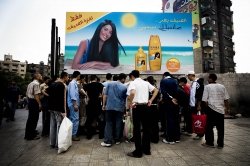MAY, 2007. It is an axiom of advertising that, to be effective, an ad must feel and look natural—and yet at the same time represent a prettier, cleaner, better version of reality, a reality to which one can aspire. But if that’s true, who is the ‘Arab woman’, and who would she like to be? The representation of women in Arab television advertising is a mishmash of the diverse cultural currents buffeting the region today. On MBC4, for example, a popular Dubai-based satellite channel that shows mostly American sitcoms and programs, one frequently shown ad depicts an olive-skinned, unveiled Arab woman who tries a skin-lightening cream called Fair and Lovely and then finds a dream job in a department store. Another Arabic-language ad spotlights a beautiful veiled young mother dressed all in white, serving Knorr soup to her family in perfect domestic bliss. In a third, a gorgeous, tanned model in a skimpy sundress throws back a 7up while sunbathing on the concrete bank of a public fountain.
Are all these ads targeting the same women, or different women? Do advertising companies have any strategy here, or are they just trying a variety of things to see what works?
In an Egyptian context, these questions are all the more compelling. Television available to Egyptian viewers comes predominately from two sources: government-run Egyptian local television, and NileSat, the Egyptian-government satellite broadcaster, which carries Arabic-language programming from Saudi Arabia, Dubai, the United Arab Emirates and other Arab countries. Local Egyptian television is notorious for shunning the hijab, or headscarf—newscasters on local television are still banned from wearing the veil, despite a variety of Egyptian court rulings calling for women fired over the issue to be reinstated. Even though an estimated 80 percent of Egyptian women wear a hijab in public today, it’s still rare to see a veiled woman in an ad specifically targeting the Egyptian market. It’s a different story on NileSat. Most ads there target the regional market, and that means the vibe is part sexy-video clip inspired, part-religious and conservative. Advertisements shown in Saudi Arabia must show veiled women. Ads aiming for the Kuwaiti, Dubai and other Gulf markets, on the other hand, try to mix things up a bit, often going for the stylish, attractive, but conservative style that is increasingly becoming a trend among elites in the region.
“You have to respect the lifestyle of each market,” says Mohamed Anwar, the deputy CEO of TBWAEgypt, the Egyptian branch of TBWA, a top-10 U.S.-based advertising firm. Indeed, respect for culture, within bounds, seems to be the watchword of advertisers in the region when it comes to head coverings. For advertisements intended for the Gulf, women can be dressed casually and unveiled, but then men won’t be shown in the same scene of the storyboard. One 2006 KFC ad, for example, shows a group of beautiful young women at home, enjoying their fried chicken while having a girls’ night, then jumps to a separate scene of young guys eating their chicken on cushions, then going outside to leap in a sports car. Shampoo ads must of course show women’s hair, and often other cosmetic products—such as contact lenses—show unveiled women in private settings. But there is one shampoo ad in which all the women are veiled. It’s for a new product, called Safe Hair, which is shampoo specially designed for veiled women.
Women in Gulf-based satellite channel advertisements often veil even when they are depicted at home—despite the fact that there is no requirement in Islam to veil when surrounded by immediate family. Often, it is major global companies that choose to market their products in this way, targeting conservative viewers while opening the way for their ads to be shown on Saudi local television. In a recent regional satellite ad for Vicks VapoRub for example, a group of women in white veils and abayas—floor-length Islamic coats—use VapoRub to tend to their sick children at home. In the next scene, they clap for their kids in an all-women’s audience at a school play. The women dress in identical black headscarves and abayas, and don matching smiles.
But if these scenes resemble real women’s lives—however idealized— in the Gulf, Egyptian major market ads show a very different idea of a perfect life. Typical is a Mobinil ad, shown in Egyptian movie theaters in 2006. The ad—for one of the largest mobile phone companies in Egypt—shows well-dressed, young men and women hanging out in a modern, multi-leveled shopping mall, chatting and shopping. It looks much like an average afternoon at City Stars, the fanciest mall in Cairo—except not a single woman in the ad wears a veil. In reality, most women who visit the mall are veiled—and dozens of shops sell veils, too.
Photograph by Myriam Abdelaziz.
There are no government restrictions on veiling in Egyptian ads, and veiled women are shown on Egyptian-produced soap operas and dramas. Still, the hijab is a sensitive issue in Egypt, in large part because the government associates its rising use with religious fundamentalism in the society, and, by extension, with support for their Islamist political opposition, the Muslim Brotherhood. Suzanne Mubarak, the first lady, is not veiled, nor are most high-ranking women in the ruling National Democratic Party. The Minister of Culture, Farouk Hosni, recently called the veil a “regressive trend”—leading to calls for his resignation by Muslim Brotherhood representatives in parliament.
The marketplace, in theory, should be less interested in ideology, and more interested in what sells. Politics aside, if advertisers in Egypt really want female viewers to identify with their campaigns, shouldn’t they be showing more women in the hijab?
That’s the question I brought over to TBWAEgypt last February, an ad agency which represents a variety of major international clients, including Motorola, Masterfoods, which makes Galaxy chocolate, Nissan and Sony. The office, which is located on a busy street in Mohandissen, resembles a stereotypical advertising shop from an American movie set—low-sided cubicles, colorful walls filled with advertising samples, hip young people in jeans and button-down shirts perching on desk corners.
The first thing I learn is that the use of the hijab in Egyptian advertising is a sensitive subject that few people want to discuss at length, especially with a Western journalist. I’m only here through a friend, and lucky to have gotten this appointment. But once inside, there is some interest in the subject. What seems so obvious to an outsider—that there seems to be a schizophrenia about how the hijab is being used on TV compared to on the streets—is just now becoming noticeable to many Egyptians. State television in Egypt began broadcasting in 1960, in an era when veiling among upper class women was uncommon and fashions resembled what was on the street in Paris. The Egyptian film and television industry has always featured glamorous, unveiled women like Faten Hamama, who has been starring in films since 1940—no matter what women’s fashion trends were apparent on the streets. The same goes for advertising. “Since we’ve known advertising in this market, the women shown have been unveiled. So the safe thing for companies to do is to show unveiled women. It’s neutral, because this is what everybody is used to seeing,” said Mourad Rachid, account director at TBWAEgypt.
What is news here in Egypt is that women in hijab, for the first time, are slowly beginning to appear in advertising specifically aimed at Egyptian consumers on Egyptian national and satellite channels, and that’s what is peaking the interest of the young TBWA executives. It’s a phenomenon that was nearly unheard of—except in seasonal ads targeting Ramadan and other religious holidays—until “two or three years ago, maximum,” Rachid said. “This didn’t happen before, definitely it’s new.”
Rachid, who has worked at the company for more than a decade, compiled a report on veiling in Egyptian advertising recently on behalf of a client, an Egyptian bank who wished to know if they should portray veiled women in their ads.
The first company to focus on showing women in the hijab, Rachid found, was the Olympic Group, a major Egyptian company which manufactures and sells home appliances such as refrigerators and heaters. About two years ago, it started a campaign which was completely at odds with what was happening in the market. All of the women in its ads were veiled: in press ads, outdoor billboards, and in their TV campaign.
Why did Olympic do it? Market considerations were a factor, but more important was the company’s image of itself and how they sought to portray themselves to the public. Olympic owners are known in the Egyptian business world as devout—and they sought to represent their products in a religious light. The campaign drew a great deal of attention, with some consumers applauding the move, and others criticizing it as striking a false note.
Since then, at least three other companies have featured veiled women in their Egyptian ads: i2, a mobile phone retailer with major shareholders in the Gulf; and two banks—Greek-based Pireaus bank and French-based Crédit Agricole. “I wouldn’t quite say it’s a trend yet. It’s just something, until now, that’s started to appear,” Rachid said.
The slow movement toward depicting veiled Muslim women in Egyptian ads is reflective of many social trends. Among them: The popularity of the veil among upper middle class and affluent women, something uncommon 20 years ago, is creating a more appealing market for retailers. (Boutiques selling veils and conservative fashions are ubiquitous in Cairo’s high-end shopping areas, and female preachers regularly hold private learning sessions, or salons, on Islamic themes in middle class homes). Devout Muslim music stars, like Sami Yusuf, feature veiled women in their video clips and enjoy great success. An increasing number of high-profile Egyptian actresses, such as Hanan Turk, Abeer Sabry, and Mona Abdel Ghany, have taken the veil and will now only accept roles in keeping with Islamic standards of modesty, opening the possibility that stardom and the veil can coexist. In the broader retail world of Cairo, shops owned by pious owners and staffed only by men—like the cut-rate department store Tawhid wa in-Nour (a Quranic phrase which refers to the oneness and light of God) are popular and expanding.
Still, most Egyptian ads will continue featuring unveiled women for a while yet, said Anwar, the TBWAEgypt Deputy CEO. One key reason is practical. Once an actress dons the veil, she is considered a representative of her religion, and has to act in a modest manner. Therefore, the creative director’s options for how to portray her in an advertisement become more limited. Showing her singing or dancing, for example, would be impossible—and she normally ends up in a home or all-female setting. If given the option, ad agencies prefer to give their creativity a wider berth.
Photograph by Myriam Abdelaziz.
Portraying more veiled women could also make unveiled women feel excluded from the marketer’s intentions, Anwar said. Some 5 to 10 percent of Egyptians are Coptic Christian, and a significant number of middle and upper-class Egyptians choose not to veil. Using unveiled women is a safer bet—a kind of default value in Egyptian advertising that has developed over time. According to Anwar, the unveiled option doesn’t offend veiled women but at the same time doesn’t exclude anyone. In an interesting finding, focus groups run by TBWA found “no difference” in Egyptians’ desire to buy a product whether the woman in the ad was veiled or unveiled, Anwar said. That’s in keeping with the reaction of a random sampling of AUC students—potentially key targets for a wide range of advertising products—when asked what they thought about using the hijab in advertising. “A woman wearing a hijab is the same as a woman not wearing one,” said Jihan Shata, a 20-year-old mass communications major at the American University in Cairo (AUC). “I only notice when it feels forced and intentional, like with Olympic Electric, which went out of their way to show only veiled women.”
Anwar also has a different opinion about the veil in Egypt than many sociologists; he believes that many Egyptian women who wear it do so from social pressure and are not convinced. Ads which feature young women liberated from parental and other restrictions, he said, offer advertisers an effective image of modernity and freedom. “The new generation is not really happy with the hijab, they want to feel free. They want to do whatever they want, but still some conservative families ask for the hijab. But the majority now aren’t convinced,” he said.
Among young women on the AUC campus, the attitude toward showing veiled women in advertising was mixed. Most women interviewed said they approved of the hijab being worn in ads, as long as there was still some balance between veiled and unveiled women. “I think showing veiled women is a good idea, because veiling is part of the society, so why not include it in all of its aspects?” said freshman Layla al-Farra, 19, who wears hijab. “I don’t know if seeing a woman in a hijab would encourage me to buy something, though,” she said.
So far in Egypt, ads have tended to show either all veiled or all unveiled women. The rarest category of all has been an ad which shows veiled and unveiled women chatting or hanging out together, which is an everyday sight on AUC’s campus. When asked to think of such an ad, the executives at TBWA could only think of one example—a seasonal Vodafone cellular phone service ad that ran during an Islamic holiday. Perhaps the future will hold more such advertisements, which could be more reflective of the multiple sides of Egyptian society.
Mixed ads could definitely appeal to the market, Rachid agreed. “You cannot go to the extreme. In this market some women are veiled, some are not. In the end, you have to show your target audience you are thinking of them,” he said.
Sharon Otterman is a contributing editor for Arab Media & Society. She has spent the last year and a half researching and writing articles about women and political reform in Cairo. Her articles have been published by the San Francisco Chronicle, The Christian Science Monitor, The Washington Times, and United Press International. A Fulbright scholarship winner, she holds a Masters in International Affairs from Columbia University .
 Arab Media & Society The Arab Media Hub
Arab Media & Society The Arab Media Hub







